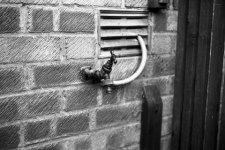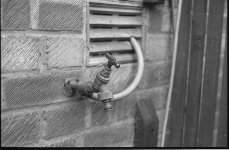- Messages
- 462
- Name
- Dave
- Edit My Images
- Yes
I have a small stash of Fomapan 100, Fomapan 200 (bulk roll, yet untried) and Kentmere Pan100 all in 35mm.
I have at last settled down on just a few cameras for my future film use (but there's always a danger of GAS adding more).
Past anomalies in my image developing weren't worth trying to correct as these were thought to be down to the old cameras I was trying. Some only got a couple of films through them.
I have a few "fun" cams to use now and then, as their flaws can give a certain character to my images, but my proper work will be done on my Pentax and Cosina SLRs.
One thing has been fairly clear whilst processing film from all cameras, this is the apparent image difference between my main films, Fomapan100 and Kentmere Pan100.
The scan (below) of negatives that I would consider to be reasonably well exposed and of a good density for scanning, shows a consistent difference between them.
The left image is typical of Fomapan 100 and the image on the right is typical of several from Kentmere Pan100, both developed in 1:50 Rodinal 20c, 5 secs agitation/min at the dev time given in the massive dev chart. (Fomapan suggests 8-9 mins so gets 8.5min).
As you will see, the contrast on the Fomapan is much higher than the Kentmere. I will reduce the dev time of the Fomapan to try to calm it down a little, but by how much, and.. should I adjust the exposure?
Test scene (close focus) out of direct sunlight.


I have at last settled down on just a few cameras for my future film use (but there's always a danger of GAS adding more).
Past anomalies in my image developing weren't worth trying to correct as these were thought to be down to the old cameras I was trying. Some only got a couple of films through them.
I have a few "fun" cams to use now and then, as their flaws can give a certain character to my images, but my proper work will be done on my Pentax and Cosina SLRs.
One thing has been fairly clear whilst processing film from all cameras, this is the apparent image difference between my main films, Fomapan100 and Kentmere Pan100.
The scan (below) of negatives that I would consider to be reasonably well exposed and of a good density for scanning, shows a consistent difference between them.
The left image is typical of Fomapan 100 and the image on the right is typical of several from Kentmere Pan100, both developed in 1:50 Rodinal 20c, 5 secs agitation/min at the dev time given in the massive dev chart. (Fomapan suggests 8-9 mins so gets 8.5min).
As you will see, the contrast on the Fomapan is much higher than the Kentmere. I will reduce the dev time of the Fomapan to try to calm it down a little, but by how much, and.. should I adjust the exposure?
Test scene (close focus) out of direct sunlight.


Last edited:

